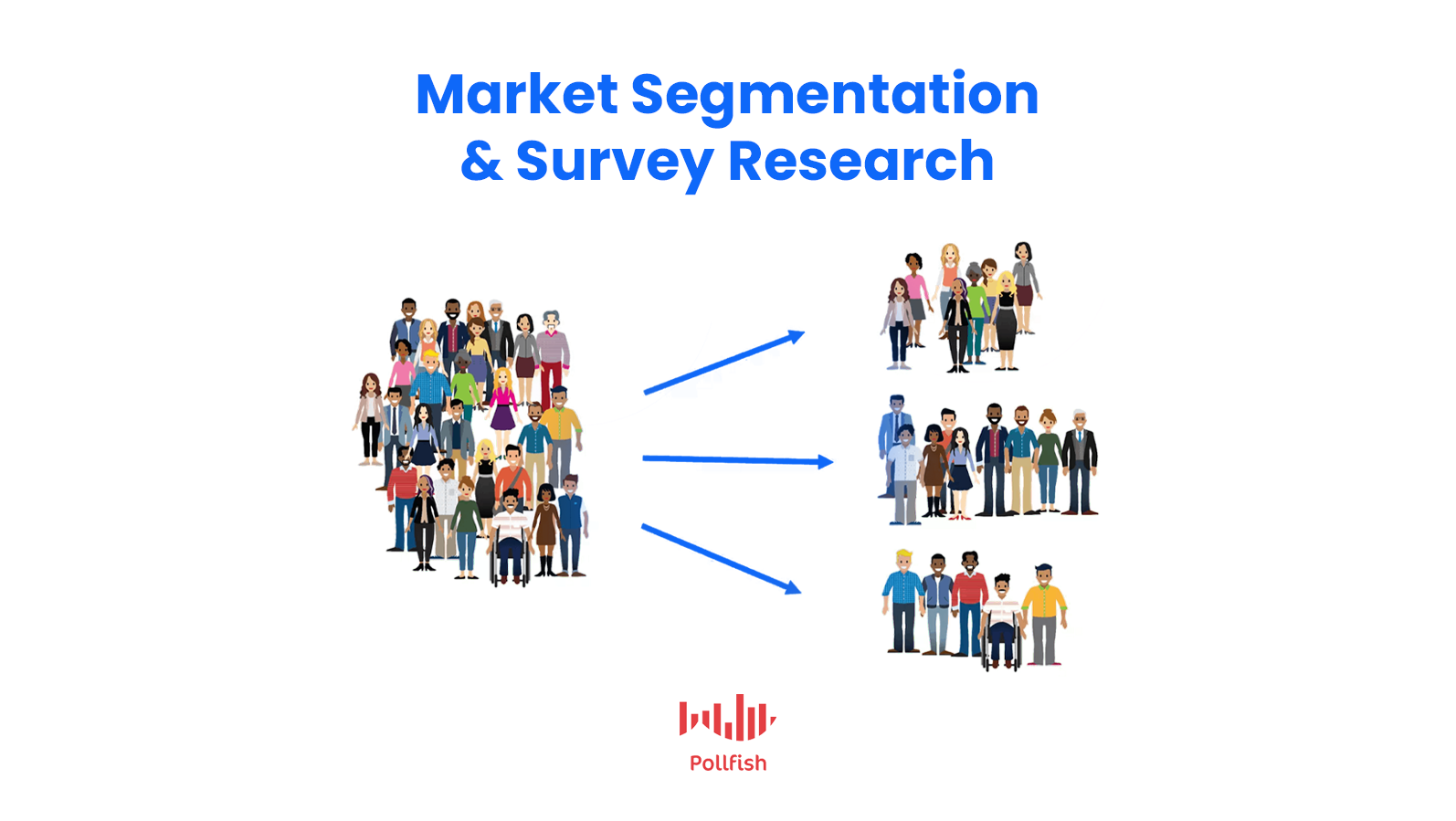How to Conduct Market Segmentation with Survey Research

In the world of an ever-increasing need to be customer-centric, conducting market segmentation is an absolute necessity. That is largely because customer experience (CX) has set the stage for business success.
86% of consumers have said they would pay more for a better customer experience and 89% said they would stop doing business with a brand that delivers a poor CX.
However, despite these stark outlooks, only 1% of brands consistently meet these expectations, according to consumers. Clearly, there is much work to be done on the customer experience and customer-centricity fronts.
To create optimal customer experiences, brands must profoundly understand their target market. Although this may seem to be a demanding feat, market segmentation provides the missing pieces to the puzzle.
Although it exists as a separate discipline from survey research, when you pair market segmentation with survey research, your brand is armed with a wealth of knowledge on how to properly cater to your customers’ needs.
This article will explore how to do market segmentation in survey research.
What is Market Segmentation?
Market segmentation is a sub-discipline within marketing, in which you divide your brand’s broader target audience into smaller segments or subsets, based on various criteria such as demographics, behaviors, needs, opinions, interests, and other standards to better categorize your target market.
The better you understand your segmented audience, the more effectively you can target your consumers for various business needs, such as product development, sales, brand awareness and most importantly, customer retention.
For example, market segmentation allows you to understand how to improve your advertising based on segments such as low vs middle income, men vs women, those who enjoy online shopping vs those who don’t.
The Benefits of Market Segmentation
This practice offers more benefits than the ones listed above. The contributions of each of these benefits weed out unproductive marketing practices, thereby saving you time and money. Here is a list of the several advantages of market segmentation.
- Gather pain points on specific segments. These pain points are not present within the entirety of your target market, proving the need to segment it. When you segment your consumers, you’ll understand each of their issues on a more intimate level, allowing you to resolve them faster (and know of their existence).
- Convey stronger marketing messages. This practice allows you to avoid coming across as too vague and impersonal. Instead, by understanding your different segments, you’ll be able to create more specific and personalized messages, the kind that speak better to certain groups.
- Avoid making the mistakes of your competitors. Your competitors aren’t going to admit their shortfalls at any time, unless they were able to bounce back ten times stronger. As such, you can use market segmentation to understand how particular marketing, offerings or experiences fell short among particular customer segments.
- Pique the interest of high-quality prospects. Well-targeted messages will lure in the most likely segments to increase sales in your target market. These are the consumers who don’t merely click on your ads, but actually make purchases
- Gain a larger reach by using the right channels. Segmentation helps you uncover the best digital (and other types) of channels through which to market to your segments. Some segments may prefer content, others may attend events, while others are heavy social media consumers. Understanding these preferences and being able to assign them to certain segments is key. You wouldn’t want to spend resources on a seldom-used channel by your segments.
- Identify niche markets. Finding particular segments is known as niche marketing, meaning that your product/service is not necessarily niche, but certain segments of your target market form their own niches. Segmentation enables you to market to these niche audiences, so that you can create new products/services for your underserved segments.
- Accumulate brand loyalty. Brand loyalty is ever important, as it is a pillar of a profitable business; it virtually guarantees that your target market will continue buying from your brand and think of your brand first when they need something from your industry.

How to do Market Segmentation
Before you begin on survey research, which is a crucial stage in market segmentation, you need to carry out the segmentation process at its basic levels. This means understanding all the major steps that make up this practice.
The following steps provide an overview of how to do market segmentation. Note that this article covers segmenting your market by four types in the following section.
- Study your market. Conduct market research via secondary resources and the market research survey. What you should seek:
- What’s the market demand for your product/service? Is it large or too small (niche)?
- How does your brand fit into your overall market?
- Find the proper type of segmentation. Market segmentation is conducted through 5 categories of study: demographic, psychographic, geographic and behavioral (explained in the next section). Choose which your brand needs to study the most; you don’t need to focus on just one. Instead, you can do market segmentation with a few or even all of these criteria.
- Continue doing market research. When you settle on which type of segmentation you are going to conduct, you’ll need to perform it via market research. You can do so by conducting more secondary research and implementing primary research as well. For the latter, focus on questions that relate to the above categories. You should create more personalized ones as you come to grips with your segments.
- Categorize and develop your customer segments. Gather all your research based on which of the 5 types of segmentation you use, and all the secondary and primary research you garnered. Group customer types into their various commonalities, as part of the 5 methods. Group them into segments and personas.
- Create new marketing strategies accordingly. Test them out on your newly found customer segments. This is not only beneficial for general marketing purposes but can lead to finding new personas within your segments.
The 5 Types of Market Segmentation
The previous section presented a general rundown of the market segmentation process. The core of this process, as its name implies, is the segmenting portion, i.e., step two. This is because market segmentation is divided into 5 sorts. These classifications will help you understand you to better market to and serve your segmented customer base.
Demographic Segmentation:
This segmentation type creates groupings of customers based on their demographics. These include categories such as gender, age, education, race, ethnicity, occupation, income level et al. Demographics is the most prominent and widely-used type of segmentation. Many products have been developed simply based on and for particular demographics.
Geographic Segmentation
This type of segmentation focuses on locations such as countries, territories, states, counties, cities, zip codes and others. Although it can exist as a demographic category, it is also regarded as its own type of segmentation. This segmentation is critical for marketing, as customers within different geographical regions have their own sets of needs, preferences and limitations.
This segmentation is also of great use to market research, especially specific types, such as real estate market research or quantitative research, when you need to make generalizations on segments in particular locations.
Behavioral Segmentation:
This divides markets by behaviors and behavioral patterns. The focus is on actions such as consumer purchases, loyalty, lifestyle, usage of products/services in your industry, device preferences and brand interactions. Conducting this segmentation will inform you on how the different subsets in your target market behave in relation to your brand and your industry at large.
These behaviors are crucial to know so that you can create a more tailored marketing approach and better user experiences. That is because this segmentation allows you to glean how your customers make purchases and by how much.
Psychographic segmentation:

This categorizes people based on the psychologically driven aspects of behaviors. As such, the target market is divided on the basis of certain opinions, values, personalities and inclinations. Psychographic segmentation is the type of classification that not only allows you to assign segments to groups of people, but to pick their brains.
That is because you can create surveys centered on each of these segments to understand the intentions and feelings of a particular consumer group. This segmentation is especially useful in qualitative research, as it helps you pinpoint trends in opinions and uncover the causes behind actions.
Firmographic Segmentation
Comparable to demographic segmentation, this kind factors in demographics, except the kind that zero in on organizations. As such, this segmentation method would study aspects such as company industry, type, size and employee count, among others.
This is useful for a number of market research campaigns. You can use it to aid competitive analysis along with understanding your consumers from the perspective of their employment. Most of all, this segmentation is crucial for B2B businesses as it helps you discover how to market to other companies. You would certainly need to know how to divide this customer base into smaller markets.
Using Survey Research for Market Segmentation
Market segmentation is a clever practice for market research and marketing purposes. This is because it allows you to narrow your focus in advertising, social media and other marketing campaigns, to a smaller group of people who are nonetheless a part of your target market, the consumer group most likely to buy from you.
This methodology should therefore remind you that you should not merely focus on broad campaigns when addressing your target market. You should keep in mind that this market tends to be wide-ranging, thus has its own subsets that differ from one another.
In addition, survey research, as laid out in several above examples, is key to deploy when conducting market segmentation. But it is also crucial to employ after conducting market segmentation, as surveys allow you to dig deeper into the minds of your consumers.
Market segmentation (led primarily by survey research), like other marketing activities, must be acted upon. For example, if you were able to segment your target market into several categories, how will you know how to give them precisely what they need? Survey research will help you find out, not to mention help you avoid unproductive marketing campaigns.
Frequently asked questions
What is market segmentation?
Market segmentation is the process of dividing a brand’s audience into smaller groups (segments) based on more narrowly defined characteristics of the group.
What is the purpose of market segmentation?
Market segmentation is performed to help a company better understand its customers or potential customers by focusing on the varying needs of each specific segment.
What are some of the applications of market segmentation?
Market segmentation can be used to understand the needs of each segment in order to improve products or services, create more effective marketing campaigns, identify new markets, encourage brand loyalty, explore the competition, and expand the reach of marketing channels.
What is demographic segmentation?
Demographic segmentation is used to create market segments based upon the demographics of existing or potential customers.
What is geographic segmentation?
Geographic segmentation is used to create market segments based upon location. The location size may be small (e.g. neighborhood or specific zip code) or large (e.g. state or country).
Do you want to distribute your survey? Pollfish offers you access to millions of targeted consumers to get survey responses from $0.95 per complete. Launch your survey today.

